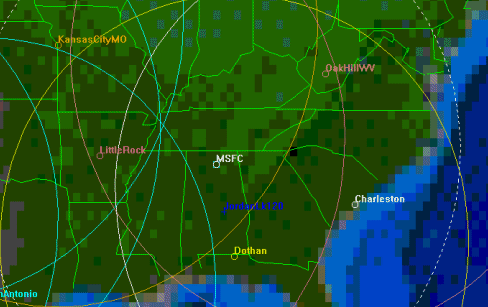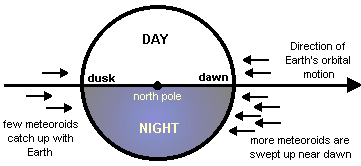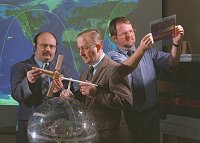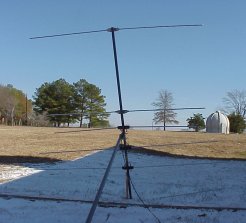
|
Choose one of these links to listen to NASA's forward scatter meteor radar system at the Marshall Space Flight Center in Huntsville, AL:
A meteor radar echo sounds like this: MP3 or RealPlayer or wav There's more: Astronomer-engineer Stan Nelson (pictured right with a home-brewed 67 MHz antenna) operates a 67.3 MHz forward scatter system in Roswell, NM, similar to the one at the Marshall Space Flight Center in Huntsville, AL. Click on the links below to listen to that system.
Nelson also monitors a 217 MHz signal from the powerful Naval Space Surveillance Radar (NAVSPASUR) in Kickapoo, TX. Much like NASA's monitoring system in Huntsville, Nelson's receiver records a ghostly ping whenever a meteor streaks over the Navy's Texas transmitter. You can listen to the action in real time using the links below:
Note: These are experimental resources and we can't guarantee that they will be available at all times. If you experience problems, please send email to the webmaster. He can't respond to each message, but he does read them all and will try to fix any technical difficulties. |
|
THE MSFC ONLINE METEOR RADAR back to spaceweather.com
Right: From left to right Cooke, Anderson, and Suggs examine Leonid meteoroid impact angles in Nov. 2000. As meteoroids plunge through Earth's atmosphere they disintegrate at an altitude of 80 to 130 km. The fiery trails they leave behind are full of ionized gases that reflect radio waves. Amateur radio operators routinely use a layer of Earth's atmosphere called the ionosphere (which is ionized by solar ultraviolet radiation) to bounce shortwave signals over the horizon for long distance communications. Disintegrating meteoroids create a short-lived mini-ionosphere that disappears as electron and ions in the trail can recombine to form neutral molecules. But for a few seconds distant radio signals can bounce off the meteor trail, giving rise to a radar-like "ping" in receivers below. A typical echo sounds like this. By counting such echoes, scientists can estimate the number of tiny meteoroids in the vicinity of our planet.
"The antenna we use [pictured left] is a 6-element Yagi; it is a commercially available cut-to-frequency channel 4 TV antenna sitting on the ground and pointed straight up," says Dr. Rob Suggs of the MSFC Engineering Directorate. "We use the CW demodulator on our Icom PCR-1000 so that 67.250 MHz (channel 4 zero offset) appears at about 700 Hz. This also inverts the passband so that the doppler shift of meteor echoes is reversed (frequency increases rather than decreases to the 'zero' frequency of the trail echo). The filter is set to 3 kHz bandwidth and the AGC is turned off." "The closest transmitters on this
frequency are in Dothan, AL, Charleston, SC, Oak Hill, WV, Little
Rock, AR, and Kansas City, MO," he continued. "The
map, below, shows local Channel 4 zero offset TV transmitters
with a circle around each showing the areas they illuminate down
to an altitude of 100 km (typical meteor altitude). Although
the transmitters are over the horizon for our station on the
ground, a meteor at 100 km over us has a direct line of sight.
The scattering geometry is tricky, that's why we frequently see
a meteor visually but don't hear any echo from it."  According to McKinley, in his book Meteor Science and Engineering, the largest numbers of echoes are observed directly over the receiver site and directly over the transmitter site. The longest-lasting echoes are recorded between the sites, a few degrees off the line connecting the two. Radio meteor rates are usually highest near dawn and lowest near dusk. That's because the dawn sky is moving directly into the swarm of space dust surrounding our planet. Just as bugs splatter on the front windshield of a moving car, but not on the rear windshield, lots of meteoroids hit the dawn sky, but very few can catch up with the sky at dusk.  Above: The rate of meteor activity is usually greatest near dawn because the earth's orbital motion is in the direction of the dawn terminator. Earth scoops up meteoroids on the dawn side of the planet and outruns them on the dusk side. For more information about meteor radars, please read these Science@NASA headlines: |
 Rob
Suggs, Bill Cooke and Jeff Anderson of the Marshall Space Flight
Center Engineering Directorate have constructed an experimental
"meteor radar" in Huntsville, AL, to monitor near-Earth
meteoroid activity above the southeastern United States.
Rob
Suggs, Bill Cooke and Jeff Anderson of the Marshall Space Flight
Center Engineering Directorate have constructed an experimental
"meteor radar" in Huntsville, AL, to monitor near-Earth
meteoroid activity above the southeastern United States. The
MSFC meteor radar is tuned to 67.25 MHz, which allows the system
to record echoes from an array of Channel 4 TV transmitters around
the southeastern USA. All of the transmitters are over the horizon
as viewed from the Marshall Space Flight Center, so it is normally
impossible to detect them. But when a meteor races by, the distant
TV signals bounce off the ionized meteor trail and down onto
the MSFC antenna.
The
MSFC meteor radar is tuned to 67.25 MHz, which allows the system
to record echoes from an array of Channel 4 TV transmitters around
the southeastern USA. All of the transmitters are over the horizon
as viewed from the Marshall Space Flight Center, so it is normally
impossible to detect them. But when a meteor races by, the distant
TV signals bounce off the ionized meteor trail and down onto
the MSFC antenna.